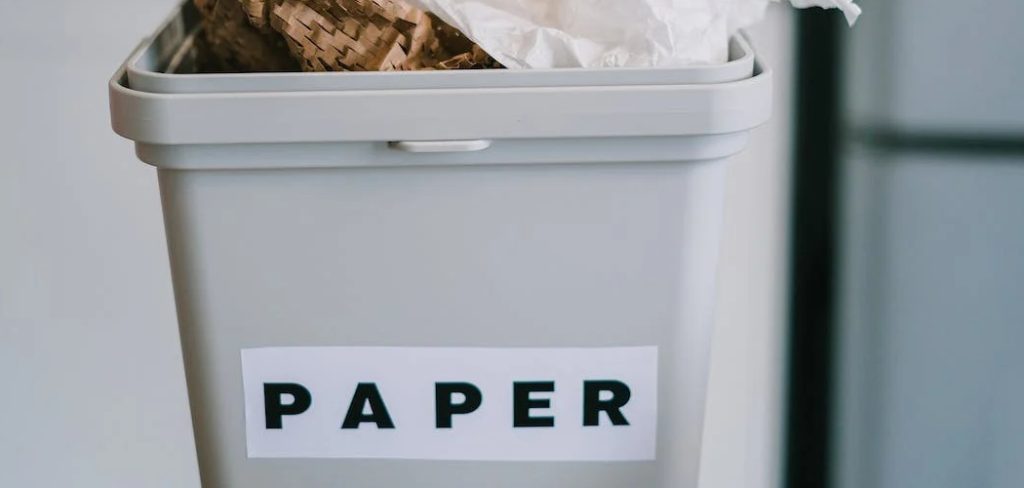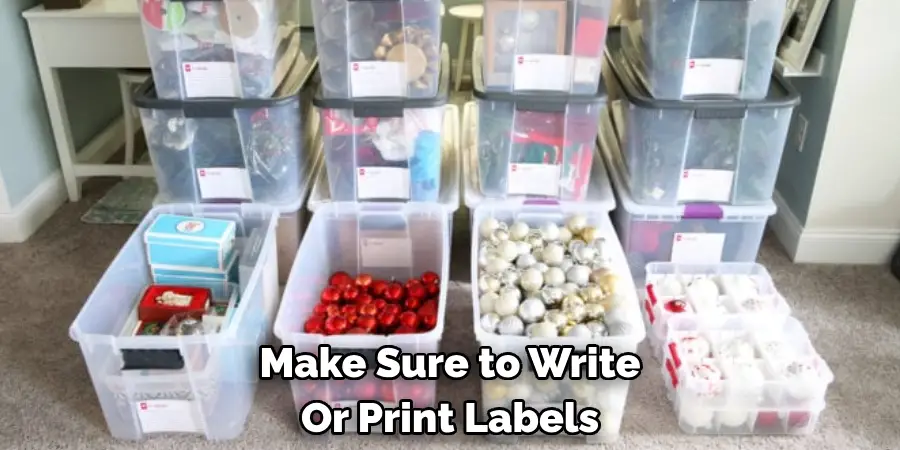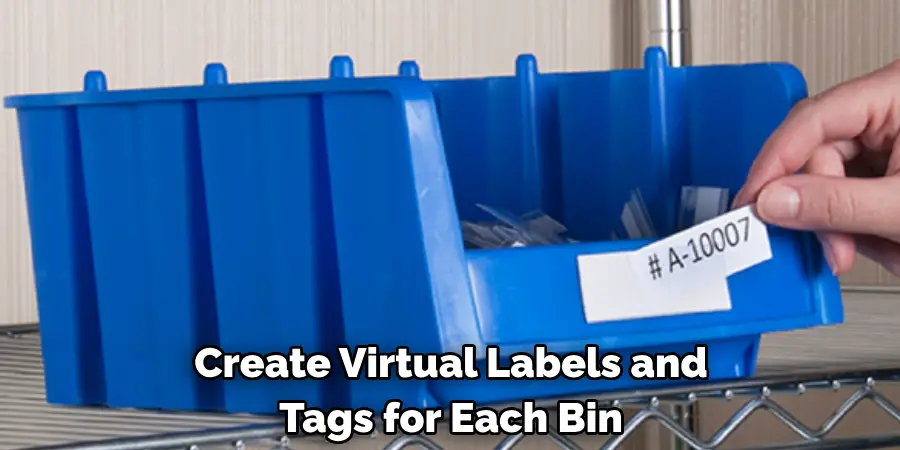Labeling storage bins is an essential task in organizing your belongings. Not only does it help you easily locate items, but it also keeps your space clutter-free and promotes a systematic approach to storage. Moreover, labeling storage bins can save you time and effort when searching for specific items. Instead of rummaging through multiple unlabeled boxes, you can simply refer to the bin’s label and retrieve what you need.
The main advantage of labeling storage bins is to keep track of the items stored in them. This allows for easier retrieval when needed, especially if there are multiple bins in a storage area. Labeling also helps with organization and categorization of items, making it easier to find specific items or groups of items. It can also save time and effort by preventing the need to search through all the bins to find a particular item. In this blog post, You will learn in detail how to label storage bins.

Step by Step Processes for How to Label Storage Bins
Step 1: Inspect and Sort
Before labeling your storage bins, it is essential to inspect and sort the items you plan to store. This will help you determine how many bins you need and what size they should be. It will also allow you to group similar items together for better organization.
Step 2: Gather Supplies
To label storage bins effectively, you will need the following supplies:
- Storage bins (preferably clear for easy visibility)
- Labels or tags
- Marker or label maker
- Tape (if using paper labels)

Step 3: Create a Labeling System
Decide on a labeling system that works best for you. It can be as simple as using numbers or letters, or you can opt for more detailed labels with item descriptions. Make sure to choose a system that is easy to understand and use consistently.
Step 4: Label the Bins
Using your chosen labeling system, label each bin accordingly. If using paper labels, make sure to secure them with tape to prevent them from falling off. For plastic bins, you can use a label maker or permanent marker for long-lasting labels.
Step 5: Include a List
Consider including a list of items stored in each bin either on the label or inside the bin for easy reference. This is especially helpful when storing seasonal items that may not be needed year-round. Make sure to write or print labels clearly and legibly. This will prevent any confusion and ensure accurate identification of items in the bin.

Step 6: Place Labels in a Visible Area
Position the labels in a visible area on the bins, preferably on the front or top. This will make it easier to read and locate when searching for items. When storing multiple items, group similar items together and label them accordingly. This will help with organization and save time when retrieving items.
Step 7: Update Labels When Needed
If the contents of a bin change, make sure to update the label accordingly. This will prevent any confusion in the future and maintain an accurate labeling system. As you continue to use your storage bins, regularly review and reorganize them for maximum efficiency. This will ensure that your labeling system remains accurate and helps you stay on top of your storage situation.
By following these steps, you can create a labeling system that works best for your needs and makes storing and retrieving items a breeze.
Tips for How to Label Storage Bins
- Avoid using handwritten labels. Instead, opt for printed labels that are easy to read and won’t fade over time.
- Use clear and concise labeling that accurately describes the contents of the storage bin.
- Place labels on all sides of the bin for maximum visibility.
- Include important information such as expiration dates or fragile items in the label description.
- Regularly check and update labels to ensure accuracy and avoid confusion.
- Use waterproof labels if storing items in a damp or humid environment.
- If using barcode labels, make sure to scan them regularly to keep track of the contents and location of the bin.
When it comes to organizing storage bins, proper labeling is crucial for maintaining a neat and efficient system. Not only does it save time and prevent frustration when searching for specific items, it also helps ensure the safety of yourself and others who may handle the bins.
How Often Should Labels Be Updated or Changed on Storage Bins?
Storage bins are essential for organizing and storing items in a warehouse or storage facility. They come in different shapes, sizes, and materials to suit various storage needs. One important aspect of using storage bins is labeling them correctly. Labels help identify the contents of each bin quickly and accurately, saving time and effort when retrieving items.
In general, labels should be updated or changed whenever necessary to maintain an organized and efficient storage system. If the contents of a bin change frequently, then the label should be updated accordingly. For example, if a bin is used to store seasonal items that are rotated frequently, the label should be changed each time the contents are rotated. This ensures that the label accurately reflects the current contents of the bin and avoids confusion or mistakes when retrieving items.

Are There Any Labeling Techniques to Make Finding Items in Storage Bins Easier?
There are several labeling techniques that can be used to make finding items in storage bins easier. These include:
1. Color-coded Labels
Color coding can be a very effective way to organize and label storage bins. By assigning specific colors for different categories of items, it becomes easier to visually locate the bin containing the desired item.
2. Numbered Labels
Numbering the storage bins is another labeling technique that can be used. This provides a systematic way to organize the items and locate them by using the assigned number.
3. Alphabetical Labels
Similar to numbered labels, alphabetical labels provide an organized way of locating items in storage bins based on their first letter.
4. Labeling with Pictures
For those who are more visual-oriented, labeling with pictures can be a helpful technique. This involves attaching a picture or drawing of the item on the label, making it easier to identify and locate.
5. Labeling with Barcodes
Barcoding is another labeling technique that is commonly used in warehouses and large storage facilities. Each bin is assigned a unique barcode which can be scanned using a barcode scanner, making it quick and efficient to find items.
6. Labeling with Descriptions
This labeling technique involves writing a brief description of the items on the label. This can be helpful for more specific or less commonly used items that may not have a designated category.
Overall, the key to making finding items in storage bins easier is to choose a labeling technique that is organized and easy to understand for your particular storage system. It may also be beneficial to use a combination of techniques for different categories of items within the same storage space. With proper labeling, you can save time and frustration when searching for items in your storage bins.
How Can We Make Label Updates or Changes Without Damaging the Storage Bin or Its Contents?
There are a few different methods for labeling clear storage bins so that the contents are still visible. One option is to use adhesive labels or stickers that can be easily removed without damaging the bin. These labels can also be written on with markers or pen to clearly identify the contents of the bin. Another method is to use dry erase markers directly on the surface of the storage bin. This allows for easy updates or changes to the label without damaging the bin or its contents. However, this method may not be as durable and could rub off over time.
For a more permanent solution, clear plastic sleeves can be attached to the storage bins with labels inserted inside. This way, the labels are protected from wear and tear while still being easily visible through the clear plastic. Additionally, the labels can be easily swapped out if contents in the bin change.

To prevent label mix-ups or confusion when multiple storage bins have similar labels, it is important to use clear and specific labeling. This could include using color-coded labels or numbering each bin to correspond with a list of contents. It may also be helpful to include information on the label such as the date or specific location where the bin is stored.
Are There Any Software or Digital Options for Labeling and Organizing Storage Bins?
There are several software and digital options available for labeling and organizing storage bins. These tools can help streamline the process, making it easier to locate items and keep track of inventory.
One popular option is barcode labeling software. This allows you to create custom barcodes that can be scanned using a barcode reader. You can assign each bin a unique barcode, making it easy to quickly identify and locate specific items. Barcode labeling software can also be integrated with inventory management systems, making it easier to track stock levels and restock bins when necessary.
Another option is using digital platforms or apps specifically designed for organizing storage bins. These platforms allow you to create virtual labels and tags for each bin, which can then be easily searched and sorted through. Some even have features such as photo and voice recognition, making it even easier to identify and locate items. Another helpful tool is cloud-based storage systems. These allow you to store digital copies of labels and inventory lists, making it easy to access them from any device with an internet connection.

Conclusion
In conclusion, the process of labeling storage bins is an essential step in organizing and decluttering any space. It not only adds a visual element to your storage system but also helps with efficiency and ease of access. Labeling storage bins can be approached in various ways, from using color-coded labels to implementing a numbering system. Whichever method you choose,
make sure it is practical and easy to understand for yourself and others who may need to access the bins. Labeling storage bins can also be a fun and creative task. You can personalize your labels with unique designs or use different fonts and colors to make them more visually appealing. I hope this article has been beneficial for learning how to label storage bins. Make Sure the precautionary measures are followed chronologically.
You Can Check it Out to Build Scrapbook Paper Storage


